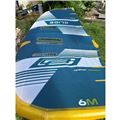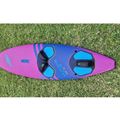1:29 PM Sun 23 Oct 2011 GMT

|
|
'Rear range lights in US waters often show an isophase characteristic, or equal periods of light and dark. Divide the number next to the (Iso) symbol in half. This Iso 6s rear range light would show 3 seconds of light followed by 3 seconds of dark.'
Captain John Jamieson
|
Did you know that you can use a navigation range to locate your exact position along any compass course? And you can do this without plotting anything onto your nautical chart?
Objects are said to be 'in range' when one lines up on top of the other. For example, hold your arms straight out in front of you. Point the index finger of each hand toward the ceiling. Now, move one finger beneath the other until they line up. You have aligned your fingers 'in range' when you do this.
You use this same method when you steer on two objects. This will help you line up in the center of a channel and will tell you in an instant when you're off course. Follow these five facts to learn the secrets of ranges...
Large harbors often have Coast Guard maintained ranges on each end of deep water channels to help ships keep lined up in the channels. Each range consists of a structure built on pilings with a dayboard on top. One range structure is built (or positioned) higher than the other.
Each range carries a rectangular or triangular shaped dayboard with a central vertical stripe. As a ship or boat enters the channel, they line up the upper and lower dayboards to form an unbroken vertical line. This indicates that they are in the deepest, central part of the channel.
At nighttime, some ranges show lights. The lower range carries a quick flashing light and the taller range a fixed (F) light or isophase (Iso) light.
Isophase lights show equal intervals of light and dark. In the illustration, the rear range shows an Iso 6s light. This means the light comes on for three seconds and then goes off for three seconds. This sequence continues from dusk until dawn. To stay 'on range' and in the center of the channel, keep both lights stacked in a vertical line.
Navigational charts with Coast Guard ranges show a solid line in the middle of the channel. This tells you it's safe to continue to use the range. Near the end of the channel, it turns into a dashed line (see both illustrations). At this point, stop using the range and change course to avoid dangerous shoal water.

|
|
Locate the point on the range line where the solid line turns into a dashed line (arrow). Stop using the range and change course at this point. Note the rear range on this chart shows a fixed light (F). The front range shows a quick flashing light (Q). - Captain John Jamieson
|
Expect deep draft ships to use the center of the channel to stay on range. Rule 9 of the Navigation Rules states, 'A vessel of less than 20 meters in length or a sailing vessel shall not impede the passage of a vessel that can safely navigate only within a narrow channel or fairway.' In busy shipping channels, keep to the right side of the channel center to avoid collision with a larger vessel.
If Coast Guard maintained ranges aren't present, look for natural ranges that line up with your compass course. A piling and the edge of a roof, a church spire and a radio tower, or two points of land.
If these objects are on your chart, draw a line out from the objects, just like you see in the illustrations above. Scan all along the line to make sure you have good water and that the course clears all shoals and dangers. Dash the line and draw an arrow (see illustration above) to indicate the point where you need to stop using the range and change course.
Use Three Steps to Stay on Range: Wind, seas and current can combine to make steering on a range a challenge. Use these tips to regain range when these natural forces push you off your trackline:
Ranges Ahead
1. Concentrate on the lower range.
2. Lower range to the left? Steer left to get back onto the range-line.
3. Lower range to the right? Steer right to get back onto the range-line.
Ranges Astern
1. Concentrate on the higher range.
2. Higher range to the left? Steer left to get back onto the range-line.
3. Higher range to the right? Steer right to get back onto the range-line.
~~~~~~~~~~~~~~~~~~~~
Now you know the chart navigation secrets of how ranges keep you in the channel for safety and security. Keep your small cruising boat on her compass course the fast and easy way--with man-made or natural ranges.
Captain John teaches sailing skippers the no-nonsense cruising skills they need beyond sailing school. Sign up for his highly popular Free sailing tips newsletter at
skippertips.com
Become a member for instant access to 425+ articles, video tutorials, newsletters, and free eBooks.
by Captain John Jamieson
|







